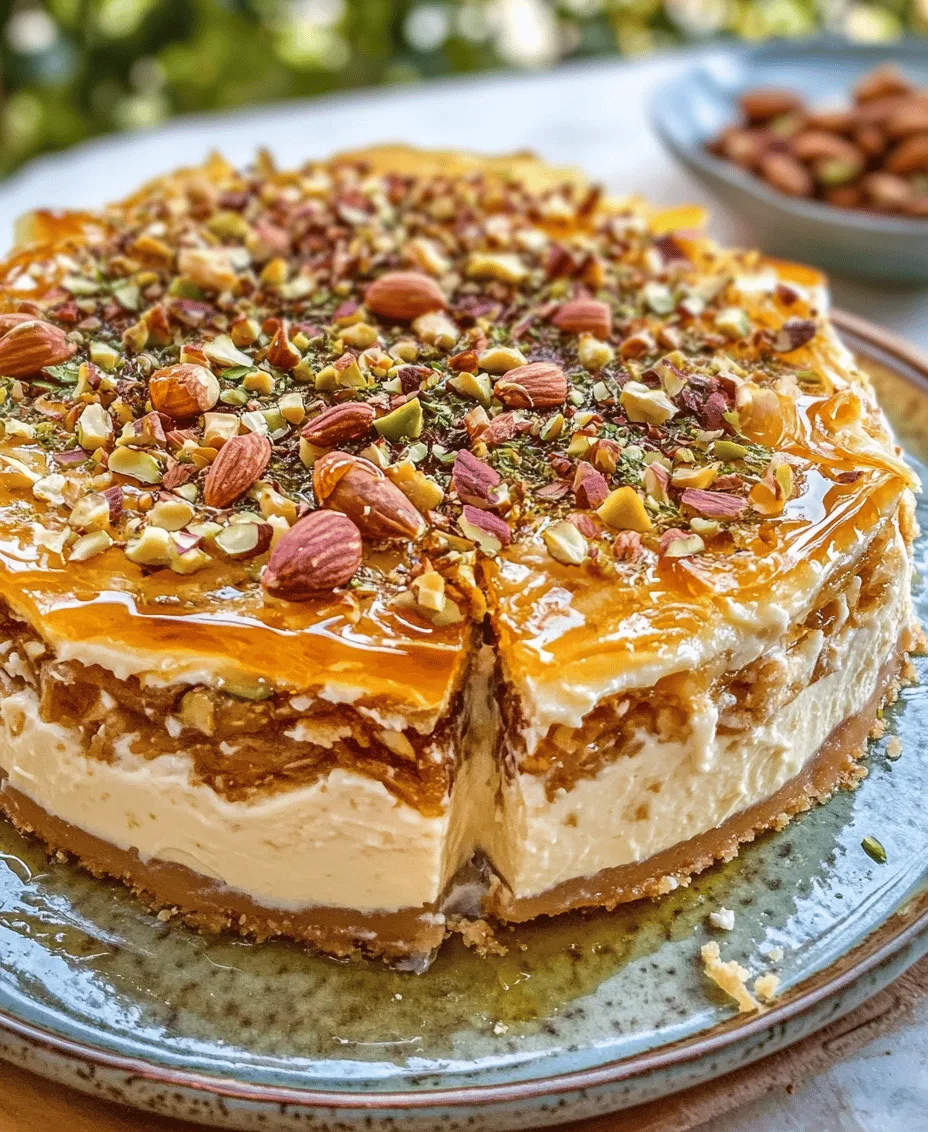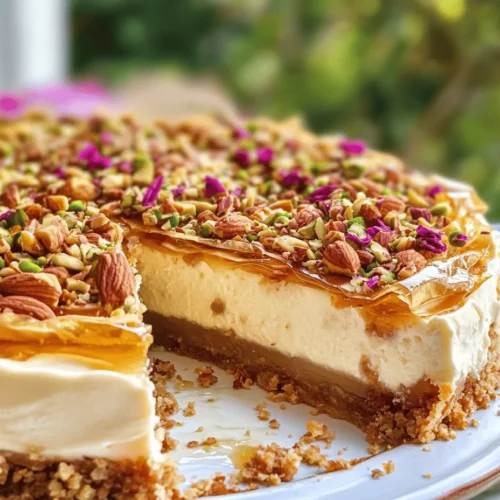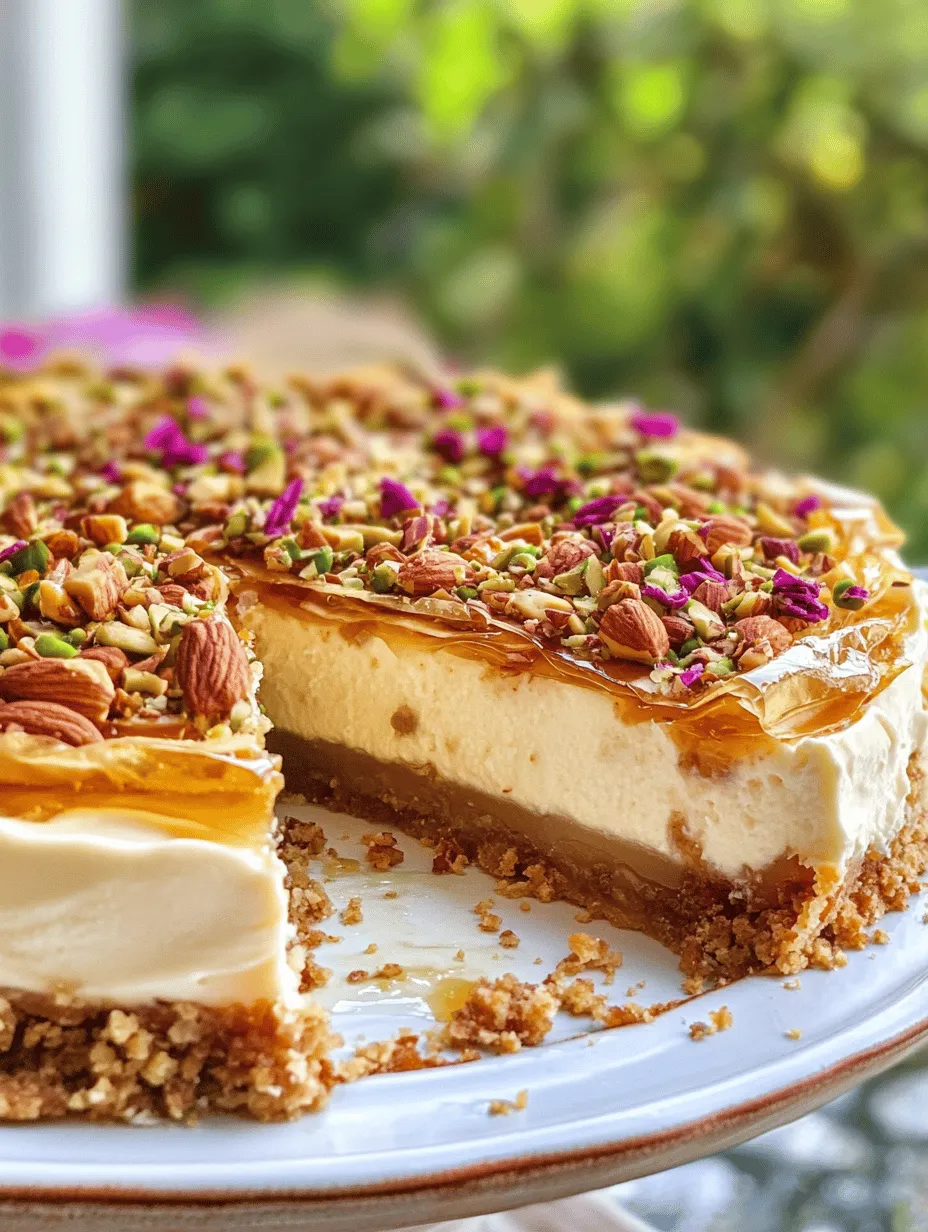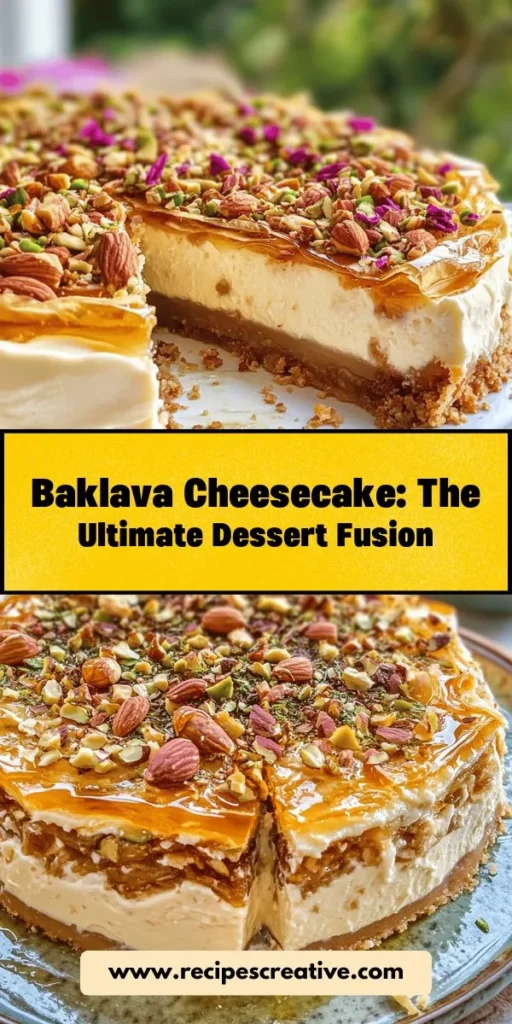Introduction
Imagine indulging in a dessert that marries the rich, nutty flavors of traditional baklava with the creamy, velvety texture of cheesecake. This is exactly what Baklava Cheesecake offers—a delightful fusion of two beloved desserts that elevates your dessert experience to new heights. Each bite reveals a harmonious blend of flaky crust, rich filling, and a sweet nut topping that captures the essence of baklava while celebrating the creamy decadence of cheesecake.
The origins of baklava can be traced back centuries, with roots deeply embedded in Middle Eastern cuisine. This traditional dessert is celebrated for its layered phyllo pastry, spiced nuts, and sweet syrup, making it a staple for festive occasions and family gatherings. On the other hand, cheesecake has its own unique history, with variations found in many cultures, including the rich, creamy versions hailing from New York. By combining these two iconic desserts, Baklava Cheesecake offers a modern twist that not only pays homage to their respective histories but also creates a new culinary experience that is sure to impress.
In this article, we will explore the detailed recipe for Baklava Cheesecake, including its ingredients, preparation steps, and the love that goes into creating this indulgent treat. Whether you’re a baklava enthusiast or a cheesecake lover, this recipe promises to captivate your taste buds and leave you craving more.
Understanding Baklava Cheesecake
To truly appreciate Baklava Cheesecake, it’s essential to understand the origins and significance of its two main components: baklava and cheesecake. Baklava is a pastry that exemplifies the art of layering and flavor balance. Traditionally made with thin sheets of phyllo dough, sweetened nuts, and a syrup made from honey and water, baklava is often flavored with spices such as cinnamon and cardamom. Its cultural significance in Middle Eastern cuisine cannot be overstated; it is often served during special occasions and celebrations, symbolizing hospitality and generosity.
On the other hand, cheesecake has a history that spans continents and centuries. The classic cheesecake, particularly the New York-style, is known for its rich and creamy texture, derived from cream cheese, eggs, and sugar. This dessert has evolved over time, with variations that incorporate different flavors and styles, from fruit-topped versions to chocolate-infused delights. The creamy base is often complemented by a graham cracker crust, providing a satisfying contrast in texture.
The fusion of baklava and cheesecake creates an unparalleled dessert that enhances both flavors and textures. The flaky, buttery phyllo crust of the baklava juxtaposes beautifully with the smooth and creamy cheesecake filling, while the nutty topping and sweet syrup add layers of flavor that appeal to both baklava enthusiasts and cheesecake lovers alike. This delightful combination results in a dessert that is not only visually stunning but also a feast for the senses.
Ingredients Breakdown
To create the perfect Baklava Cheesecake, it is essential to have a thorough understanding of each ingredient that contributes to this culinary masterpiece. Let’s break down the key components in detail.
Crust Composition
At the base of our Baklava Cheesecake is a crust made from phyllo dough, which is a traditional component of baklava. Phyllo dough is known for its delicate, paper-thin layers that, when baked, become light and flaky. The choice of nuts—typically walnuts or pistachios—combined with sugar and cinnamon forms a flavorful crust that not only provides a crunchy texture but also complements the creamy filling of the cheesecake.
– Phyllo Dough: This is the star of the crust. It is essential for achieving the characteristic flaky texture associated with baklava. When layered and brushed with butter, phyllo dough transforms into a crispy, golden crust that serves as the perfect foundation for the cheesecake filling.
– Nuts: A blend of finely chopped walnuts or pistachios adds a rich, nutty flavor to the crust. These nuts are not only flavorful but also provide essential nutrients such as healthy fats, protein, and fiber.
– Sugar and Cinnamon: The addition of sugar sweetens the crust, while cinnamon adds warmth and depth of flavor, enhancing the overall taste profile of the dessert.
Cheesecake Filling Essentials
The heart of the Baklava Cheesecake lies in its luscious filling. A combination of cream cheese and Greek yogurt creates a creamy texture that is both rich and satisfying. This filling is further enhanced with flavorings that elevate the overall experience.
– Cream Cheese: The primary ingredient in the cheesecake filling, cream cheese provides that classic creamy, tangy flavor that we all love. It is essential for achieving the rich texture that defines a good cheesecake.
– Greek Yogurt: Incorporating Greek yogurt not only adds to the creaminess but also introduces a slight tang that balances the sweetness of the dessert. It also contributes to a lighter texture, making the cheesecake less dense.
– Flavorings: Vanilla extract, cardamom, and lemon zest are added to the filling to create a complex flavor profile. Vanilla adds sweetness, cardamom introduces a unique spice that echoes the flavors of baklava, and lemon zest brings brightness, ensuring the cheesecake is not overly sweet.
Baklava Topping Ingredients
To truly capture the essence of baklava, we must not forget the topping that brings the entire dessert together. This layer is composed of a nut mixture and sweetening agents that mimic traditional baklava flavors and textures.
– Nut Mixture: A combination of finely chopped walnuts or pistachios, mixed with a bit of sugar and cinnamon, forms the topping. This nut mixture adds a satisfying crunch and nutty flavor that complements the creamy filling.
– Honey and Butter: These ingredients are used to bind the nut mixture and provide the signature sweetness associated with baklava. The honey also adds moisture, ensuring the topping remains soft and flavorful.
Syrup Preparation
The syrup plays a crucial role in adding moisture and sweetness to the Baklava Cheesecake. It is essential for tying all the flavors together and providing that authentic baklava experience.
– Sugar: The primary sweetening agent, sugar is dissolved in water to create a syrup that is poured over the cheesecake, infusing it with sweetness and flavor.
– Lemon Juice: A splash of lemon juice balances the sweetness of the syrup and adds a refreshing tang, preventing the dessert from becoming overly sweet.
– Vanilla Extract: Adding a hint of vanilla to the syrup enhances the overall flavor profile and ties in beautifully with the cheesecake filling.
Step-by-Step Instructions
Now that we have a comprehensive understanding of the ingredients that make up Baklava Cheesecake, let’s dive into the step-by-step instructions for preparing this delectable dessert. The process may seem intricate, but with careful attention to detail, you’ll create a stunning Baklava Cheesecake that is sure to impress.
Preparing the Crust
1. Preheat the Oven: Begin by preheating your oven to 350°F (175°C). This ensures that your cheesecake will bake evenly.
2. Prepare Phyllo Dough: Unroll the phyllo dough and cover it with a damp kitchen towel to prevent it from drying out. Working with phyllo can be tricky, so it’s important to keep it moist.
3. Layer the Phyllo: In a greased springform pan, lay down the first sheet of phyllo dough and brush it lightly with melted butter. Repeat this process, layering sheets of phyllo and brushing them with butter until you have about 8-10 layers. This will create a sturdy base for your cheesecake.
4. Add the Nut Mixture: In a bowl, combine finely chopped nuts, sugar, and cinnamon. Sprinkle this nut mixture evenly over the phyllo layers in the springform pan.
5. Top with More Phyllo: Continue layering additional sheets of phyllo dough over the nut mixture, again brushing each layer with melted butter, until you have about 8-10 more layers. This will create a flaky, crunchy top for your cheesecake.
6. Trim Excess Phyllo: Trim any excess phyllo hanging over the edges of the pan, tucking it in to create a clean edge.
7. Bake the Crust: Place the springform pan in the preheated oven and bake for approximately 15-20 minutes, or until the phyllo is golden brown and crispy. Remove from the oven and allow it to cool slightly before adding the cheesecake filling.
With these initial steps complete, you have laid the foundation for a delicious Baklava Cheesecake. In the next part of the article, we will continue with the preparation of the cheesecake filling and the final assembly of this indulgent dessert. Stay tuned for the exciting continuation of this delightful recipe!

Mixing the Crust Ingredients and Pressing into the Pan
To start crafting your Baklava Cheesecake, the first step is to prepare the crust, which is vital for achieving that perfect base. In a medium mixing bowl, combine 1 ½ cups of finely crushed phyllo dough or graham crackers, ½ cup of melted unsalted butter, and ¼ cup of sugar. The choice between phyllo dough and graham crackers depends on your flavor preference; phyllo will give you a more authentic baklava taste, while graham crackers offer a classic cheesecake vibe.
Using a fork or a pastry cutter, mix these ingredients until they resemble wet sand. The melted butter should be evenly distributed, ensuring that each crumb is coated. Once combined, transfer the mixture into a 9-inch springform pan. Press it firmly into the bottom and slightly up the sides to create a uniform crust. To achieve a golden, crispy base, bake the crust in a preheated oven at 350°F (175°C) for about 10-12 minutes. Keep an eye on it; you want it to turn a light golden brown without burning. Once done, remove it from the oven and let it cool while you prepare the filling.
Making the Cheesecake Filling
Now that the crust is ready, it’s time to make the cheesecake filling. In a large mixing bowl, beat together 24 ounces of cream cheese (softened to room temperature) and 1 cup of granulated sugar using an electric mixer. Mix on medium speed until the mixture is smooth and creamy, taking care to scrape down the sides of the bowl to ensure everything is well incorporated.
Next, add in 3 large eggs, one at a time, mixing thoroughly after each addition. This gradual incorporation is crucial for creating a smooth texture. Follow this by adding 1 teaspoon of vanilla extract and the zest of one lemon, which will brighten the flavor profile of your cheesecake, enhancing its richness. Blend until everything is thoroughly combined and smooth. The key here is to mix just until incorporated; overmixing can introduce air bubbles that may lead to cracks during baking.
Baking the Cheesecake
Preheat your oven to 325°F (160°C) as you prepare to bake the cheesecake. Pour the filling over the pre-baked crust, smoothing the top with a spatula for an even layer. Bake in the preheated oven for 60-70 minutes, or until the edges are set and the center has a slight jiggle. It’s important not to overbake, as this can lead to a dry texture.
Once the cheesecake is baked, turn off the oven and crack the oven door open slightly, allowing the cheesecake to cool gradually inside. This step is essential to prevent cracks from forming on the surface. After about an hour, remove it from the oven and let it cool at room temperature before transferring it to the refrigerator. Allow the cheesecake to chill for at least 4 hours, preferably overnight, to set fully.
Creating the Baklava Topping
While the cheesecake cools, prepare the baklava topping, which will add the signature flavors of this dessert. In a medium bowl, combine 1 cup of finely chopped walnuts, pistachios, and almonds (or your preferred combination of nuts). Add ½ teaspoon of ground cinnamon and 2 tablespoons of sugar, mixing thoroughly to ensure an even distribution of flavors.
Once combined, melt ½ cup of unsalted butter and brush a thin layer over the top of the chilled cheesecake. Sprinkle the nut mixture evenly over the buttered surface, ensuring every bite will be packed with flavor. The even coating is vital for achieving that delightful baklava experience in every slice.
Making the Syrup
Now, let’s prepare the syrup, which is a hallmark of baklava. In a small saucepan, combine 1 cup of granulated sugar, ½ cup of water, 1 teaspoon of vanilla extract, and the juice of half a lemon. Bring the mixture to a gentle boil over medium heat, stirring until the sugar dissolves. Once boiling, reduce the heat and allow it to simmer for approximately 10 minutes until it thickens slightly. The syrup should have a pourable consistency without being too thick.
Timing is crucial; allow the syrup to cool slightly before drizzling over the cheesecake to prevent it from melting the topping. The syrup adds moisture and sweetness, enhancing the overall flavor of the Baklava Cheesecake.
Assembling the Cheesecake
With all components ready, it’s time to assemble. Remove the cheesecake from the refrigerator and carefully release it from the springform pan. Drizzle the cooled syrup generously over the nut topping, allowing it to seep into the layers. For a beautiful presentation, consider using a spoon to create an artistic swirl with the syrup.
For an additional touch, you can garnish the cheesecake with a sprinkle of chopped nuts or a light dusting of cinnamon before slicing. Presentation is key; a well-decorated cheesecake will not only be a feast for the taste buds but also a visual delight for your guests.
Serving Suggestions
Baklava Cheesecake is a showstopper dessert that pairs wonderfully with various accompaniments. Serve each slice with a dollop of freshly whipped cream to add a light and airy texture, or consider a scoop of vanilla ice cream for a richer experience. Fresh fruits, such as berries or sliced citrus, can also enhance the dessert, providing a refreshing contrast to the sweetness of the cheesecake.
For a cultural touch, you might serve it alongside a small cup of Turkish coffee or strong black tea. The robust flavors of these beverages complement the sweetness of the Baklava Cheesecake, enhancing the overall dessert experience.
Nutritional Information
Understanding the nutritional aspects of Baklava Cheesecake is essential for those monitoring their intake. Each slice (approximately 1/12 of the cheesecake) contains around 350-400 calories, depending on the specific ingredients used. It’s rich in fat due to the cream cheese and nuts, so moderation is key.
For those with dietary restrictions, consider using gluten-free graham crackers for the crust and substitute the sugar with a sugar alternative suitable for baking. This way, you can enjoy the indulgent flavors of Baklava Cheesecake while accommodating various dietary needs.
Conclusion
Baklava Cheesecake is a delightful fusion of two beloved desserts, combining the rich, creamy texture of cheesecake with the nutty, sweet allure of baklava. Each bite offers a unique experience, bridging cultures and traditions through its flavors and presentation. This dessert is not just a treat; it’s an experience that brings people together, making it the perfect centerpiece for any gathering.
Encourage your friends and family to try making this Baklava Cheesecake—it’s a rewarding endeavor that culminates in a stunning dessert that’s sure to impress. The joy of creating and sharing this unique recipe is truly special, and once you serve it, you’ll find that the flavors and memories created will linger long after the last slice is gone.



